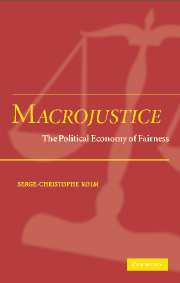Book contents
- Frontmatter
- Contents
- Presentation
- PART ONE BASES: CONSENSUS, FREEDOMS, AND CAPACITIES
- 1 Macrojustice: An overview of its place, method, structure, and result
- 2 Social freedom
- 3 The liberal theory
- 4 Free and equal in rights
- 5 Resources
- 6 Capacities
- PART TWO OVERALL DISTRIBUTIVE JUSTICE: ELIE (EQUAL LABOUR INCOME EQUALIZATION)
- PART THREE COMPARISONS WITH POLICIES AND PHILOSOPHIES
- PART FOUR THE DEGREE OF COMMUNITY, EQUALITY, RECIPROCITY, AND SOLIDARITY
- PART FIVE COMPARISON WITH ECONOMICS' SOCIAL ETHICS
- References and bibliography
- Index
1 - Macrojustice: An overview of its place, method, structure, and result
Published online by Cambridge University Press: 31 July 2009
- Frontmatter
- Contents
- Presentation
- PART ONE BASES: CONSENSUS, FREEDOMS, AND CAPACITIES
- 1 Macrojustice: An overview of its place, method, structure, and result
- 2 Social freedom
- 3 The liberal theory
- 4 Free and equal in rights
- 5 Resources
- 6 Capacities
- PART TWO OVERALL DISTRIBUTIVE JUSTICE: ELIE (EQUAL LABOUR INCOME EQUALIZATION)
- PART THREE COMPARISONS WITH POLICIES AND PHILOSOPHIES
- PART FOUR THE DEGREE OF COMMUNITY, EQUALITY, RECIPROCITY, AND SOLIDARITY
- PART FIVE COMPARISON WITH ECONOMICS' SOCIAL ETHICS
- References and bibliography
- Index
Summary
INTRODUCTIVE SUMMARY
Justice should probably be seen as a palliative to the insufficiency of the deeper human values that are the choice of one's desires and concern for others. Among the multifarious questions of justice raised in society, macrojustice is concerned with the basic rules of society and the global or overall distribution of goods and of the main resources these rules imply. The specific solution for macrojustice will be shown. This will be the solution that is desired by society, in the sense that all its members unanimously want it when they are sufficiently informed, reflective, and impartial (a property of any view about justice). This will turn out to both imply and be implied by the fact that the general rule of society is social freedom, that is, an absence of relation of force between society members: each individual is free from the forceful interference of others individually or in groups or institutions (except possibly for protecting or realizing others' such freedom). Social freedom is generally presented in the form of the classical basic rights – the basis of democratic Constitutions. Social freedom or, more directly, unanimity, will imply that the overall distribution of resources has a very simple and meaningful structure (“equal labour income equalization”). There will, however, remain to determine a degree of equalization or redistribution, about which the interests of some individuals are opposed. The methods for solving this problem again involve some consensus.
- Type
- Chapter
- Information
- MacrojusticeThe Political Economy of Fairness, pp. 9 - 39Publisher: Cambridge University PressPrint publication year: 2004
- 1
- Cited by



